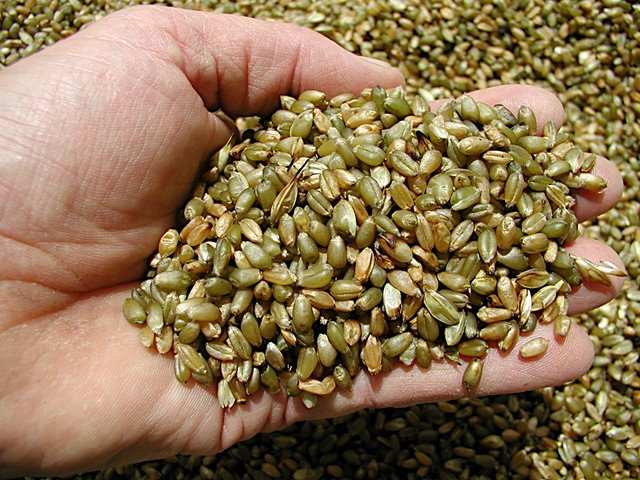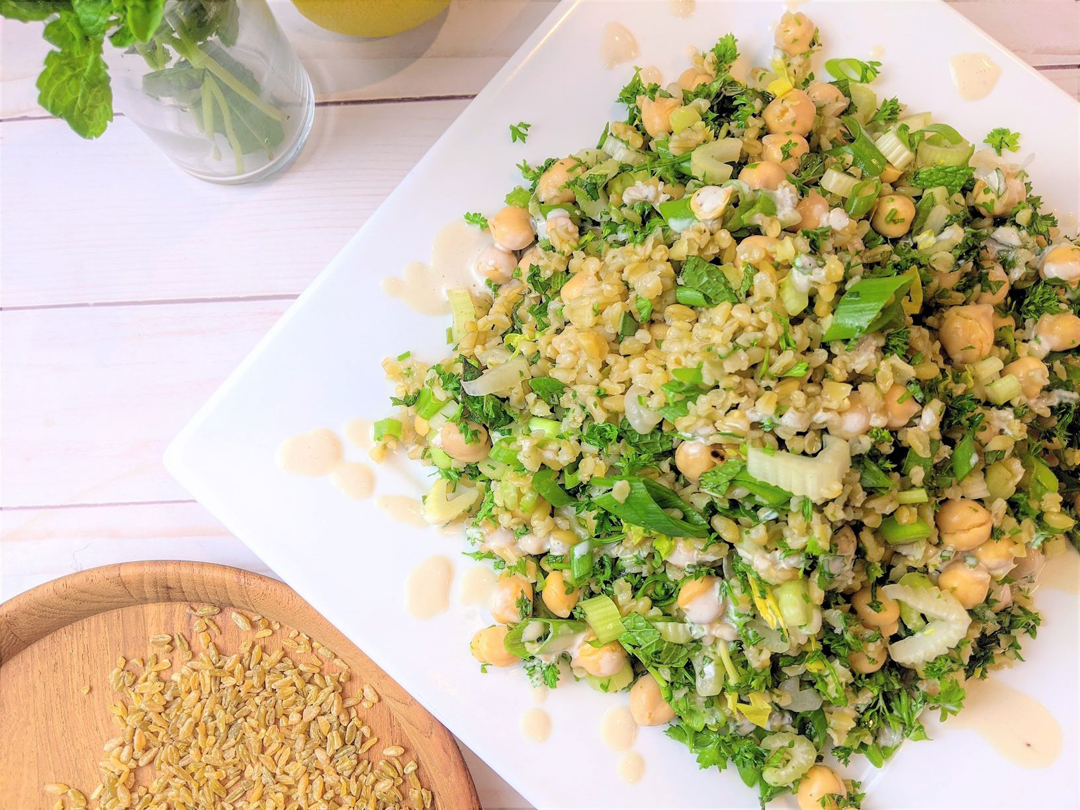Freekeh is a cereal food made from green wheat that goes through a roasting process in its production. The incredibly high fiber content of freekeh has been credited with weightloss (since fiber fills you up and keeps you feeling full), and, if you’re not eating a healthy well balanced diet already, you could probably use more fiber in your diet.

Freekeh is an old grain. Ancient, in fact. It’s been enjoyed for centuries in countries such as Syria, Lebanon, Jordan and Egypt. Now freekeh (pronounced “free-kah”) is gaining popularity in American kitchens, particularly for its nutritional punch. Compared to other grains, “It is higher in protein, fiber, vitamins, minerals and lower in glycemic index,” says Vandana R. Sheth, RDN, CDE, Spokesperson for the Academy of Nutrition and Dietetics.
It is an ancient Middle Eastern dish that is especially popular in Levantine, Arabian Peninsula, Palestinian and Egyptian cuisine, but also in North African and other neighboring cuisines. The wheat is harvested while the grains are yellow and the seeds are still soft; it is then piled and sun-dried. The piles are then carefully set on fire so only the straw and chaff burn and not the seeds. It is the high moisture content of the seeds that prevents them from burning. The now roasted wheat undergoes further thrashing and sun-drying to make the flavor, texture, and color uniform. It is this thrashing or rubbing process of the grains that gives this food its name, farik or rubbed. The seeds are now cracked into smaller pieces so they look like a green bulgur.
A similar food made from barley is mentioned in the Bible. Freekeh is mentioned in an early 13th century Baghdad cookery book as farikiyya. In that recipe, meat is fried in oil and braised with water, salt, and cinnamon bark. Then dried coriander is stirred in with young wheat (“freekeh”) and is cooked. Finally, the meal is served with cumin, cinnamon, and fresh lamb tail fat.
In Egypt, freekeh is served as hamam bil-farik (pigeon stuffed with green wheat). Shurbat farik bil-mukh is a freekeh and bone marrow soup from Tunisia. Freeket lahma, a green wheat pilaf dish with roasted lamb, spring peas, and pine nuts comes from Syria and shurba al-farik is a Palestinian soup with green wheat and chicken. In Syria the freekeh is usually prepared with lamb, onion, butter, almonds, black pepper, cinnamon, cumin and salt.

Freekeh has several nutritional attributes that are comparable to other cereal foods. Some people consider it a superfood. Cancer Research UK say that “the term ‘superfood’ is really just a marketing tool, with little scientific basis to it”. It compares well to other healthy grains such as quinoa and farro. Freekeh has at least four times as much fiber as some other comparable grains, consisting mostly of insoluble fiber. It also has a low glycemic index so is suitable for managing diabetes.
Freekeh is young green wheat that has been toasted and cracked. It’s a healthy whole grain food, much like bulgur wheat and other whole grains. Although freekeh has been around for centuries, its recent resurgence can be traced back to an Oprah segment in which freekeh was featured in 2010. Freekeh is part of the “ancient grain” food and health trend that also includes quinoa. You might occasionally see freekeh called farik or even frik.
Whole grains such as freekeh are full of essential nutrients such as selenium, potassium and magnesium. Like quinoa, freekeh makes an excellent source of protein for vegetarian and vegans.
My local Whole Foods stocks cracked freekeh along with the other packaged whole grains, but not in bulk – yet! Wegman’s and many smaller co-ops and organic grocers stock this grain as well. Freekeh importers have store locators on their website. Here’s one, and of course, it’s widely available online. It also comes pre-flavored in tamari or rosemary sage flavor. If you’ve got a local Middle Eastern grocer, they might also stock an imported brand.
Like bulgur wheat, freekeh is a whole grain, but is usually sold cracked which increases its usability, since cooking time is reduced, but doesn’t change it’s nutritional content. Cracked or not, freekeh is a healthy whole grain. Whole freekeh (uncracked) takes about 45-50 minutes to simmer, while the cracked variety takes about 15-20 minutes to soften. To prepare freekeh, you’ll want a little bit more than a 2:1 ratio of liquid to freekeh, so about 2 1/2 cups of water or vegetable broth for every cup of freekeh. Simmer freekeh, covered, for 15-20 minutes. When the liquid is absorbed and the grains are soft, they’re ready to be used. Like pasta, some people prefer to cook freekeh in salted water with a bit of oil, but this is a personal preference.
If you’re already used to cooking with whole grains, then you’ll have plenty of ideas for using freekeh, from whole grain salads, to pilafs, stir-fries, risottos, tabboulis and soups. If you can do it with rice, you can probably do it with freekeh.
Freekeh nutritional information
With less than a gram of fat per serving, freekeh is a low-fat and nearly fat-free food, and, of course, it’s vegetarian and vegan, though since it’s wheat, it’s not gluten-free. A serving of freekeh (one-fourth cup, raw) contains a healthy 8 grams of protein, less than 130 calories, and 4 grams of fiber. Vegetarians and vegans should note that freekeh also contains plenty of zinc, if that’s one of your concerns. And ladies, it’s also high in iron.

“The fact that freekeh is high in protein and fiber does provide more of a satiety feeling,” Sheth explains. “This might therefore lead to less overall calories being consumed and help with weight loss.” Freekeh has four times the amount of fiber as brown rice, according to nutrient data from Australian producer Greenwheat Freekeh. And research shows that a fiber-rich diet is linked to lower body weight.
It could protect your eyes. “Freekeh is rich in lutein and zeaxanthin both of which have been positively associated with prevention of age-related macular degeneration,” says Sheth. Lutein and zeaxanthin are carotenoids (a type of antioxidant) that promote eye health.
It may tame your tummy. Emerging research suggests that freekeh may offer benefits to digestive health. Like other high fiber foods, it may help prevent constipation and lower risk of developing diverticular disease. It can also act like a prebiotic to increase healthy bacteria in your digestive tract.
One thing to keep in mind, however, is that freekeh is not gluten-free, and therefore not safe for celiacs. It may fit into a diabetes meal plan, but it’s best to consult with your registered dietitian or health practitioner first.
Why is green wheat any different than regular wheat? Australian researchers with CSIRO (the national government body for scientific research in Australia) have found that because it’s harvested when it’s young, the grain retains more protein, fiber and minerals than in mature wheat. Freekeh also ranks low on the glycemic index. And if you compare the fiber content of freekeh to other grains, it blows them out of the water, with three times as much fiber as brown rice and twice as much fiber as quinoa. And as anyone who has ever been on a diet can tell you, the more fiber you eat, the fuller you feel and the easier it is to lose weight. What’s more, freekeh contains resistant starch, which is a type of carbohydrate that acts like a fiber and also helps to keep you feeling pleasantly satisfied longer.
Freekeh comes in both whole and cracked forms. It’s still a bit of a challenge to find in most grocery stores, but you can get it in the grain aisle at places like Whole Foods Market, Wegmans and independent health-food stores. While no bargain, it’s not atrociously expensive like some so called “superfoods.”
Another benefit of green wheat — at least the cracked kind — is that it cooks up relatively quickly compared to many whole grains — in just 20 minutes. You can use it in place of brown rice or barley in dishes like pilafs, risottos and salads. I like using cracked freekeh in tabbouleh. With its chewy texture, whole cooked freekeh is also really nice paired with yogurt and fruit in a parfait. Give the grains a toss with maple syrup or honey before layering them with the yogurt and fruit.
Disclaimer
The Content is not intended to be a substitute for professional medical advice, diagnosis, or treatment. Always seek the advice of your physician or other qualified health provider with any questions you may have regarding a medical condition.